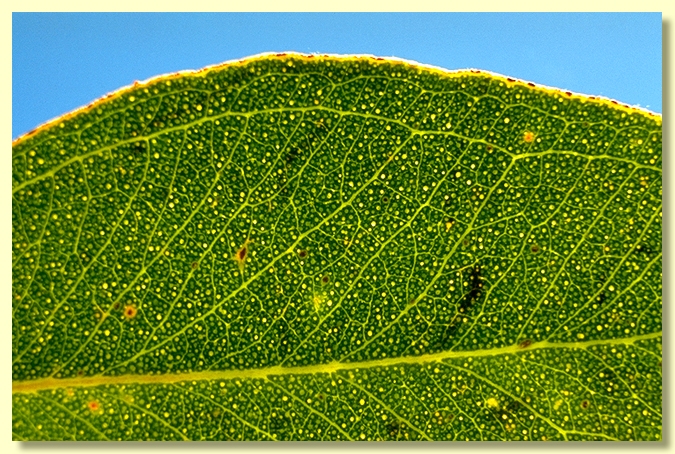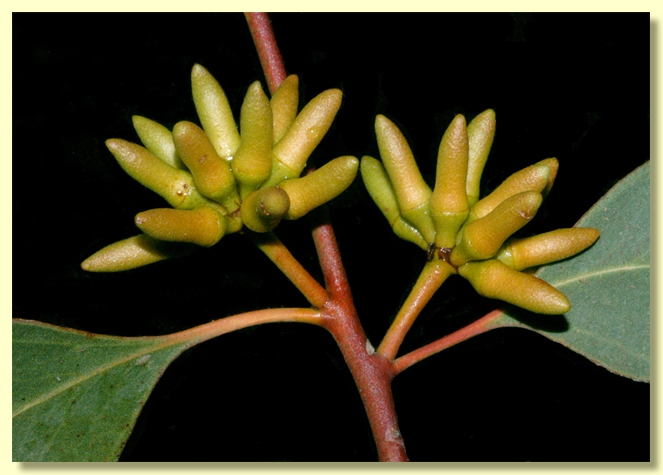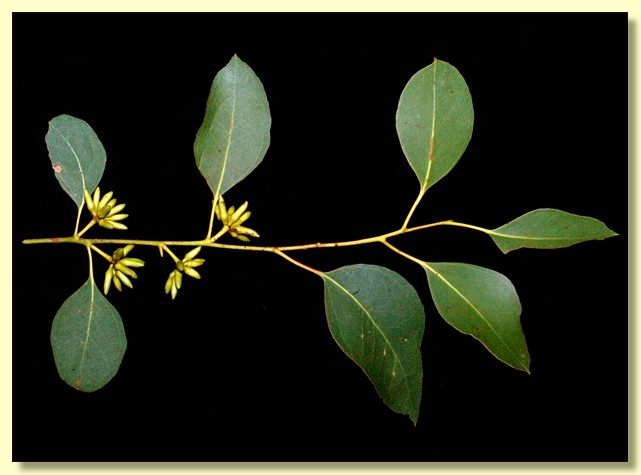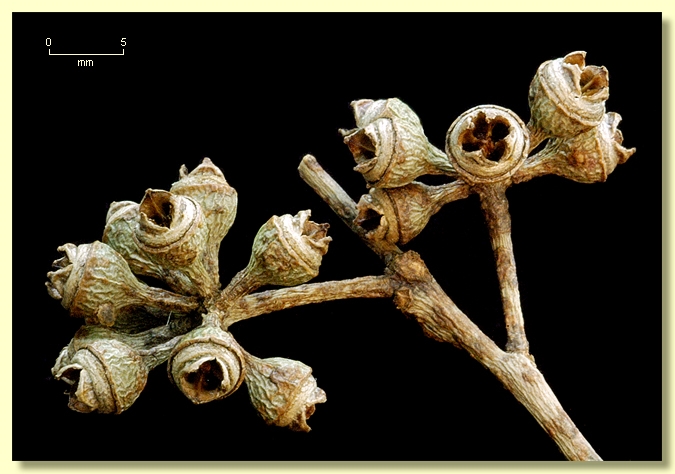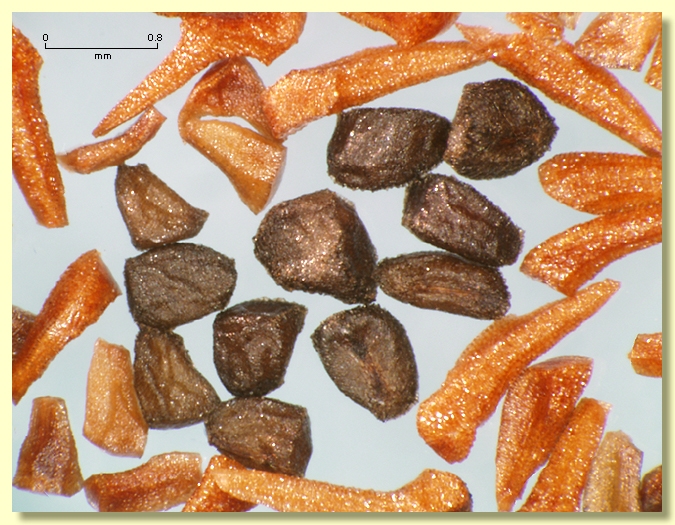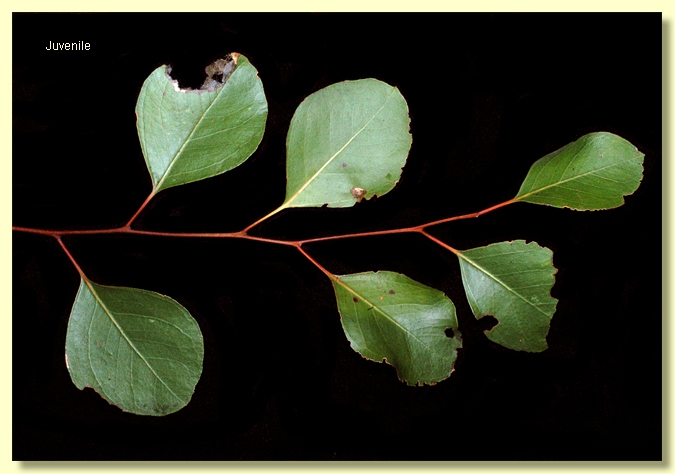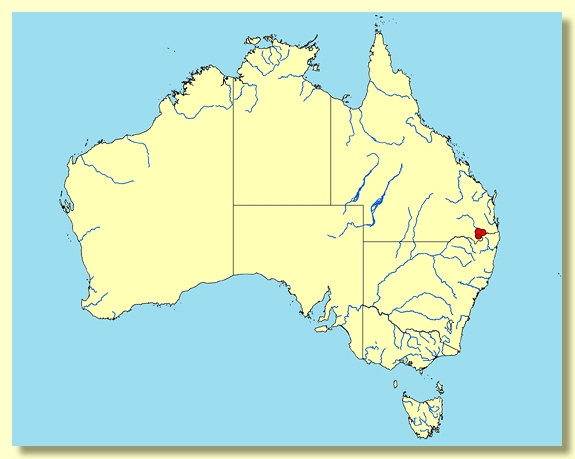Euclid - Online edition
Eucalyptus infera
Eucalyptus | Symphyomyrtus | Exsertaria | Erythroxylon
Eucalyptus infera A.R.Bean, Austrobaileya 3 (2) 291 (1990).
T: Queensland: Darling Downs District: southern end of State Forest Reserve 444, south-west of Warwick, 28° 24' S, 151° 42' E, 4 October 1988, A.R.Bean 936; holo: BRI; iso: CANB, MEL, NSW. (the CANB specimen not received).
Eucalyptus dealbata var. populnea Blakely, Key to the Eucalypts (1934). T: Queensland, Darling Downs District, Inglewood, October 1922, C.J.Smith, holo: NSW; iso: BRI.
Mallee or rarely a small tree to 8 m tall. Forming a lignotuber.
Bark smooth throughout, shiny, grey to coppery to olive-green.
Juvenile growth (coppice or field seedlings to 50 cm): stem square or rounded in cross-section; juvenile leaves petiolate, alternate, ovate to orbicular, 4–7 cm long, 4–7 cm wide, glossy green, base tapering to the petiole, apex emarginate, margin often with shallow crenulations.
Adult leaves alternate, petiole 1.2–3 cm long; blade broadly lanceolate to elliptical to ovate, 6–11 cm long, 1.7–4(5) cm wide, apex acute, base tapering to petiole, margin often with shallow crenulations, concolorous, glossy green, moderately reticulate, intramarginal vein parallel to and well removed from the margin, oil glands numerous and island. Plants are frequently reproductive with a sub-adult crown of more elliptical rather than lanceolate leaves.
Inflorescence axillary unbranched, peduncles 0.8–1.5 cm long, buds 9–18 per umbel, pedicellate (pedicels 0.3–0.5 cm long). Mature buds elongated ovoid to fusiform with operculum much longer than hypanthium (buds 1–1.3 cm long, 0.3–0.4 cm wide), yellow or creamy, smooth, scar present, operculum horn-shaped (0.8–1.1 cm long), stamens erect, anthers cuboid to oblong, versatile, dorsifixed, dehiscing by longitudinal slits (non-confluent), style long, stigma tapered, locules 3 or 4, the placentae each with 6–8 vertical ovule rows. Flowers white.
Fruit pedicellate (pedicels 0.1–0.4 cm long), hemispherical, 0.3 cm long, 0.4–0.8 cm wide, disc raised, raised disc convex to concave, sometimes oblique or vertical, valves 3 or 4, strongly exserted.
Seeds dark brown, 0.8–1 mm long, pyramidal or ± cuboid, dorsal surface smooth, hilum terminal.
Cultivated seedlings (measured at ca node 10): cotyledons bilobed; stems square in cross-section with small wings on the edges; leaves always petiolate, opposite for the first 3 to 5 nodes then becoming alternate, ovate, 5–8 cm long, 4–7 cm wide, base tapering to rounded, apex bluntly pointed to rounded, sometimes shallowly emarginate, green.
Flowering time unknown.
A mallee restricted to a small area in Queensland, just south-west of Warwick. E. infera is an odd eucalypt with the buds, fruit and seed showing strong affinities to the red gums (series Exsertae), with the buds having the long narrow horn-shaped operculum and the hemispherical fruit with the raised disc and prominently exserted valves. The juveniles and adult leaves, however, show some similarity to those of the swamp gums (series Foveolatae), with the adult leaves broadly lanceolate to ovate and the intramarginal vein well removed from the margin, and juvenile leaves orbicular to ovate. The juvenile leaves have the apex often emarginate and the margins often shallowly crenulate.
In the classification of Brooker (2000) Eucalyptus infera is placed in Eucalyptus subgenus Symphyomyrtus section Exsertaria (red gums) series Erythroxylon because the buds have two opercula, ovules are in six rows, seeds are pyramidal to cuboid and blackish, cotyledons are reniform to oblong, adult leaves are concolorous and the fruit have exserted valves. Series Erythroxylon has fifteen species which occur throughout eastern and central Australia: E. amplifolia, E. blakelyi, E. chloroclada, E. dealbata, E. dwyeri, E. flindersii, E. gillenii, E. glaucina, E. infera, E. kabiana, E. nandewarica, E. nudicaulis, E. tereticornis, E. terrica and E. vicina.
In the original description it was suggested that the similarity of the juvenile leaves with those of the swamp gums indicates some affinity of E. infera with series Foveolatae. The authors of EUCLID believe the resembleance is incidental and not an indication of natural affinity between the red gums and the swamp gums.
With its non-glaucous buds and long narrow operculum, E. infera could only be confused with E. blakelyi, E. tereticornis, E. kabiana and E. amplifolia and is easily distinguished by its dull green juvenile leaves which are also ovate, with shallowly crenulate margins and emarginate apexes, but broadly ovate to orbicular and glossy green in E. amplifolia, dull green and ovate in E. blakelyi and E. tereticornis and lanceolate in E. kabiana, with all four species having juvenile leaves with entire margins and acute apices.
Eucalyptus infera is listed as "Vulnerable" under the Australian Government Environment Protection and Biodiversity Conservation Act 1999 (EPBC Act). Further information may be found at this web address:
http://www.environment.gov.au/cgi-bin/sprat/public/sprat.pl
MORE ABOUT RED GUMS AND OTHER ASSOCIATED GROUPS
Eucalyptus infera: Latin inferus - inferior, referring to the fact that this species grows as an understorey to other eucalypts.

